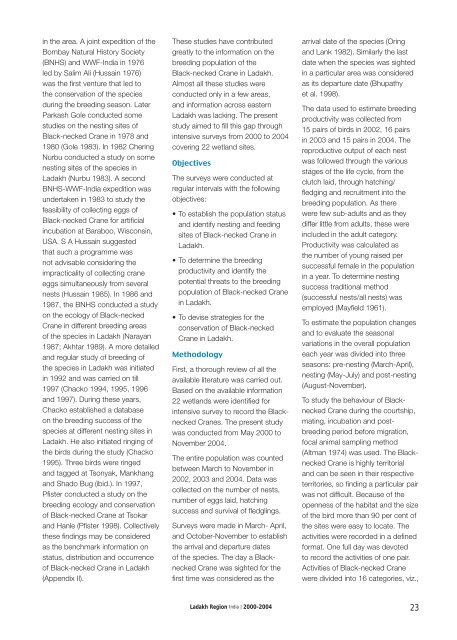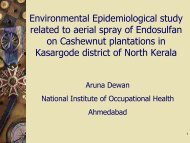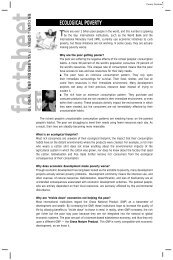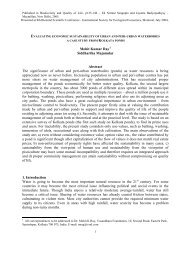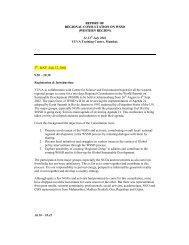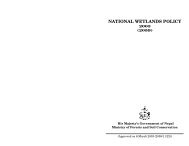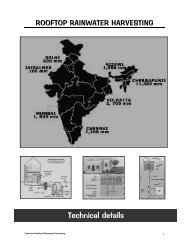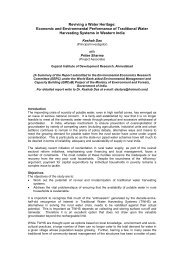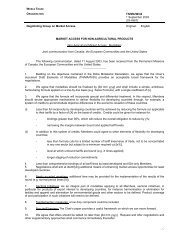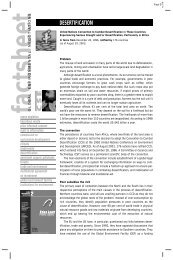Black-necked Crane - WWF-India
Black-necked Crane - WWF-India
Black-necked Crane - WWF-India
You also want an ePaper? Increase the reach of your titles
YUMPU automatically turns print PDFs into web optimized ePapers that Google loves.
in the area. A joint expedition of the<br />
Bombay Natural History Society<br />
(BNHS) and <strong>WWF</strong>-<strong>India</strong> in 1976<br />
led by Salim Ali (Hussain 1976)<br />
was the fi rst venture that led to<br />
the conservation of the species<br />
during the breeding season. Later<br />
Parkash Gole conducted some<br />
studies on the nesting sites of<br />
<strong>Black</strong>-<strong>necked</strong> <strong>Crane</strong> in 1978 and<br />
1980 (Gole 1983). In 1982 Chering<br />
Nurbu conducted a study on some<br />
nesting sites of the species in<br />
Ladakh (Nurbu 1983). A second<br />
BNHS-<strong>WWF</strong>-<strong>India</strong> expedition was<br />
undertaken in 1983 to study the<br />
feasibility of collecting eggs of<br />
<strong>Black</strong>-<strong>necked</strong> <strong>Crane</strong> for artifi cial<br />
incubation at Baraboo, Wisconsin,<br />
USA. S A Hussain suggested<br />
that such a programme was<br />
not advisable considering the<br />
impracticality of collecting crane<br />
eggs simultaneously from several<br />
nests (Hussain 1985). In 1986 and<br />
1987, the BNHS conducted a study<br />
on the ecology of <strong>Black</strong>-<strong>necked</strong><br />
<strong>Crane</strong> in different breeding areas<br />
of the species in Ladakh (Narayan<br />
1987; Akhtar 1989). A more detailed<br />
and regular study of breeding of<br />
the species in Ladakh was initiated<br />
in 1992 and was carried on till<br />
1997 (Chacko 1994, 1995, 1996<br />
and 1997). During these years,<br />
Chacko established a database<br />
on the breeding success of the<br />
species at different nesting sites in<br />
Ladakh. He also initiated ringing of<br />
the birds during the study (Chacko<br />
1995). Three birds were ringed<br />
and tagged at Tsonyak, Mankhang<br />
and Shado Bug (ibid.). In 1997,<br />
Pfi ster conducted a study on the<br />
breeding ecology and conservation<br />
of <strong>Black</strong>-<strong>necked</strong> <strong>Crane</strong> at Tsokar<br />
and Hanle (Pfi ster 1998). Collectively<br />
these fi ndings may be considered<br />
as the benchmark information on<br />
status, distribution and occurrence<br />
of <strong>Black</strong>-<strong>necked</strong> <strong>Crane</strong> in Ladakh<br />
(Appendix II).<br />
These studies have contributed<br />
greatly to the information on the<br />
breeding population of the<br />
<strong>Black</strong>-<strong>necked</strong> <strong>Crane</strong> in Ladakh.<br />
Almost all these studies were<br />
conducted only in a few areas,<br />
and information across eastern<br />
Ladakh was lacking. The present<br />
study aimed to fi ll this gap through<br />
intensive surveys from 2000 to 2004<br />
covering 22 wetland sites.<br />
Objectives<br />
The surveys were conducted at<br />
regular intervals with the following<br />
objectives:<br />
• To establish the population status<br />
and identify nesting and feeding<br />
sites of <strong>Black</strong>-<strong>necked</strong> <strong>Crane</strong> in<br />
Ladakh.<br />
• To determine the breeding<br />
productivity and identify the<br />
potential threats to the breeding<br />
population of <strong>Black</strong>-<strong>necked</strong> <strong>Crane</strong><br />
in Ladakh.<br />
• To devise strategies for the<br />
conservation of <strong>Black</strong>-<strong>necked</strong><br />
<strong>Crane</strong> in Ladakh.<br />
Methodology<br />
First, a thorough review of all the<br />
available literature was carried out.<br />
Based on the available information<br />
22 wetlands were identifi ed for<br />
intensive survey to record the <strong>Black</strong><strong>necked</strong><br />
<strong>Crane</strong>s. The present study<br />
was conducted from May 2000 to<br />
November 2004.<br />
The entire population was counted<br />
between March to November in<br />
2002, 2003 and 2004. Data was<br />
collected on the number of nests,<br />
number of eggs laid, hatching<br />
success and survival of fl edglings.<br />
Surveys were made in March- April,<br />
and October-November to establish<br />
the arrival and departure dates<br />
of the species. The day a <strong>Black</strong><strong>necked</strong><br />
<strong>Crane</strong> was sighted for the<br />
fi rst time was considered as the<br />
arrival date of the species (Oring<br />
and Lank 1982). Similarly the last<br />
date when the species was sighted<br />
in a particular area was considered<br />
as its departure date (Bhupathy<br />
et al. 1998).<br />
The data used to estimate breeding<br />
productivity was collected from<br />
15 pairs of birds in 2002, 16 pairs<br />
in 2003 and 15 pairs in 2004. The<br />
reproductive output of each nest<br />
was followed through the various<br />
stages of the life cycle, from the<br />
clutch laid, through hatching/<br />
fl edging and recruitment into the<br />
breeding population. As there<br />
were few sub-adults and as they<br />
differ little from adults, these were<br />
included in the adult category.<br />
Productivity was calculated as<br />
the number of young raised per<br />
successful female in the population<br />
in a year. To determine nesting<br />
success traditional method<br />
(successful nests/all nests) was<br />
employed (Mayfi eld 1961).<br />
To estimate the population changes<br />
and to evaluate the seasonal<br />
variations in the overall population<br />
each year was divided into three<br />
seasons: pre-nesting (March-April),<br />
nesting (May-July) and post-nesting<br />
(August-November).<br />
To study the behaviour of <strong>Black</strong><strong>necked</strong><br />
<strong>Crane</strong> during the courtship,<br />
mating, incubation and postbreeding<br />
period before migration,<br />
focal animal sampling method<br />
(Altman 1974) was used. The <strong>Black</strong><strong>necked</strong><br />
<strong>Crane</strong> is highly territorial<br />
and can be seen in their respective<br />
territories, so fi nding a particular pair<br />
was not diffi cult. Because of the<br />
openness of the habitat and the size<br />
of the bird more than 90 per cent of<br />
the sites were easy to locate. The<br />
activities were recorded in a defi ned<br />
format. One full day was devoted<br />
to record the activities of one pair.<br />
Activities of <strong>Black</strong>-<strong>necked</strong> <strong>Crane</strong><br />
were divided into 16 categories, viz.,<br />
Ladakh Region <strong>India</strong> | 2000-2004 23


